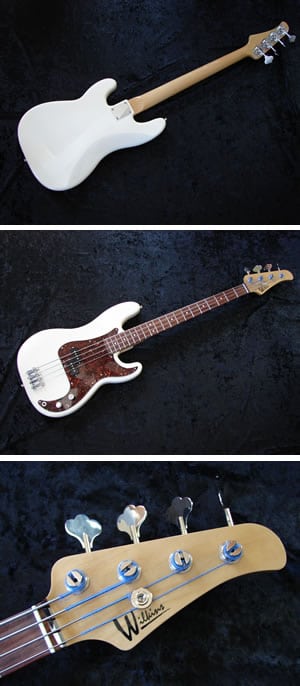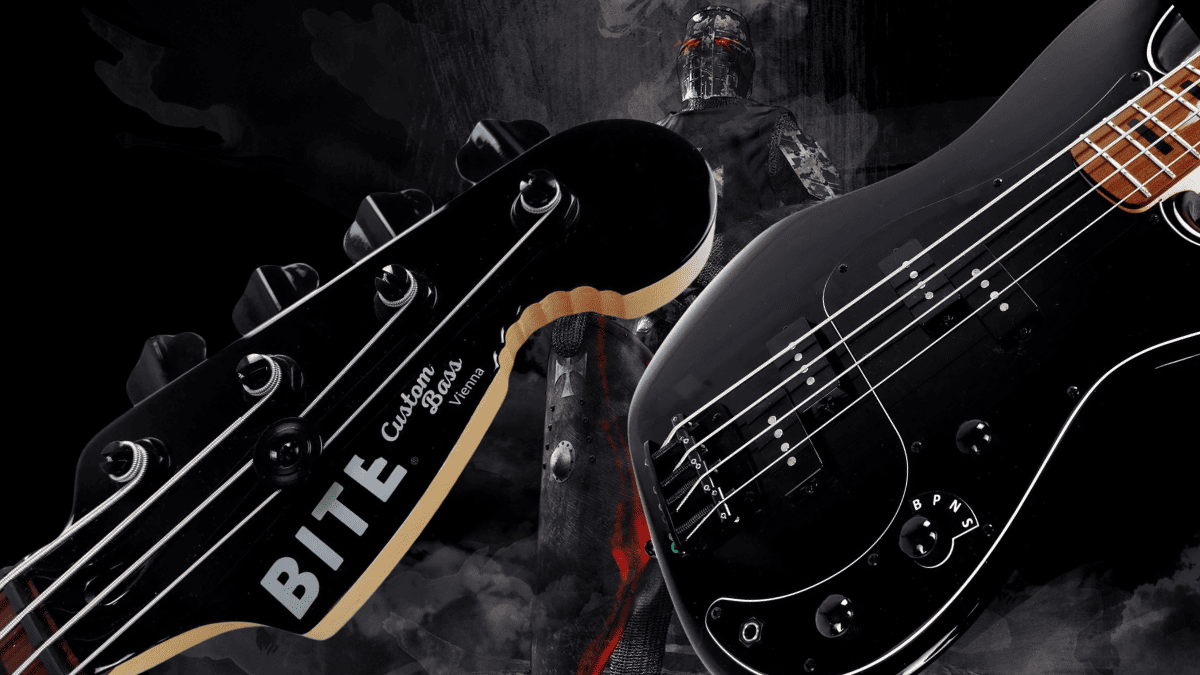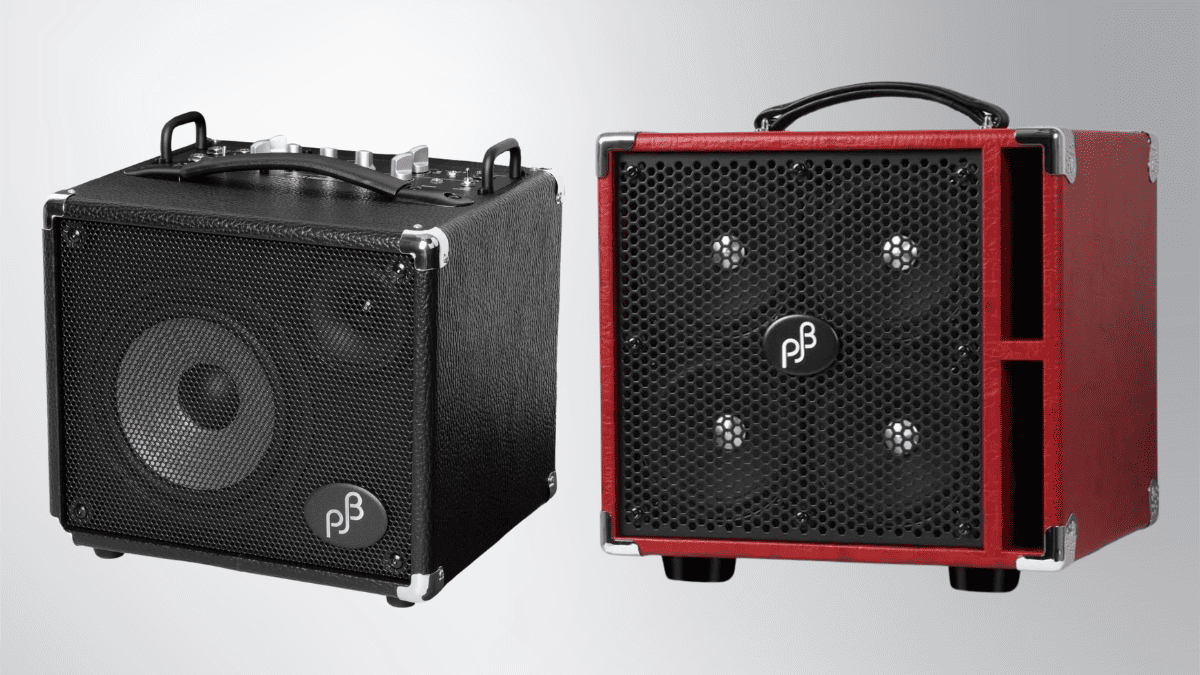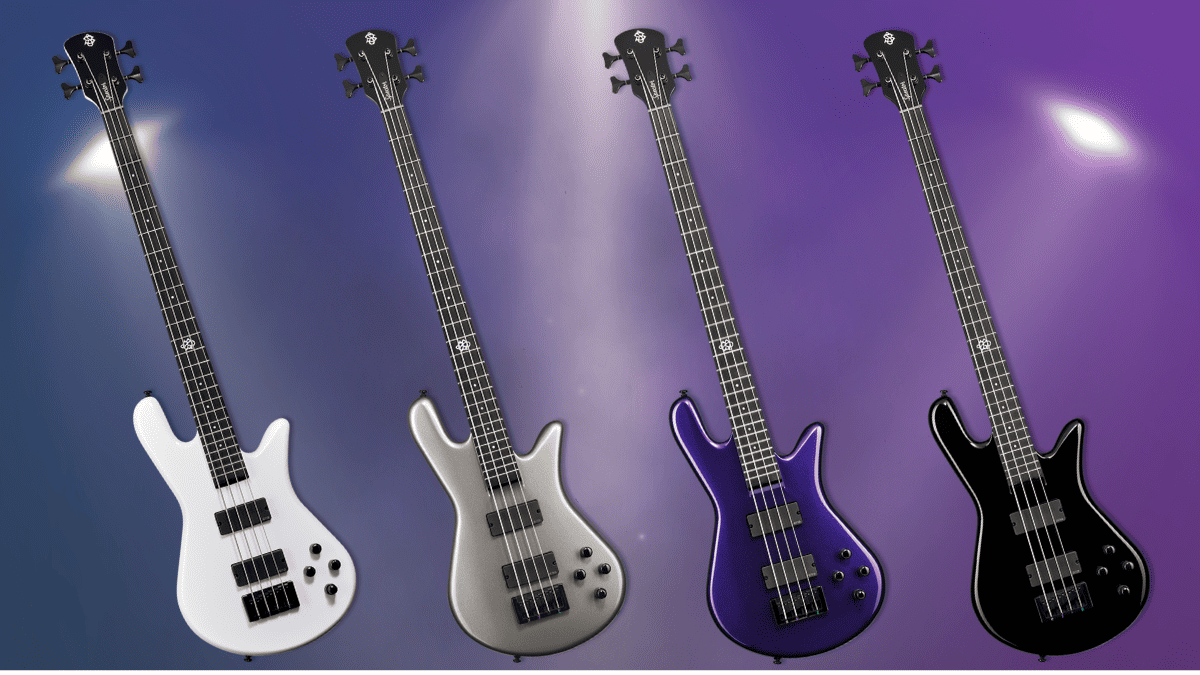Gear Reviews
Gear Impressions and Luthier Spotlight With Jake Wolf : Pat Wilkins Classic P Bass

Chances are, even if you haven’t played one of Pat Wilkins’ basses, you’re probably familiar with his work. Pat is the guy who puts those luscious and perfect finishes on US offerings by Lakland, Sadowsky, Tom Anderson, and a whole lot others. Pat has been busy doing exquisite finish work for the last 20 years, and in the meantime has somehow found the time to be building his own brand of killer axes. Go to Pats website, and you’ll see a group of fine looking J and PJ style basses, most sporting his trademark gorgeous colors over beautiful quilted and flamed maple. What you won’t see on the website is the Classic P, an under-the-radar gem that Pat recently sent to me to check out. According to Pat, this beauty was built with the intention that it be as true to an actual vintage (early 60’s) P bass as possible.
Part of what makes this bass so special is the caliber of woods used in its construction. Between the 80 year old European alder body, the 150 year old maple neck, and the 60 year old brazillian rosewood fingerboard, one could truly call this a “vintage bass” that just happens to have been recently built. Pat had the single P pickup custom wound to his specifications; he explains that it was scatter wound: a process that simulates the hand winding of a pickup, by adding some “human” variations to the wire wrap, rather than a perfect machine wind. The magnet and wire materials used were carefully selected for their approximation to true vintage materials. The tone controls’ paper and oil capacitor offers an old school tonal spectrum and taper. Pat used a real celluloid tortoise shell pickguard for the P, as opposed to the colored plastic ones found on almost all tort-guard equipped basses offered today (even most of the highest end ones). And of course, it has that Pat Wilkins Olympic white finish, which let me tell ya, is just sumptuous. When I asked Pat about the finish, he excitedly told me about this finishing method he discovered that is only being used on this series of instruments. He shared that the finish is obtained through several very thin coats of a proprietary polyurethane formula that looks and feels more like classic nitrocellulose lacquer, but offers the durability and protection of a modern poly finish. The overall result is a very thin but durable lustrous finish, which feels great under my fingers, and doesn’t have the thick plasticky vibe I’ve encountered with some gloss poly finishes.
I was lucky enough to use this bass on several different gigs and every time, it delivered the classic P bass goods superbly. For many, the formula already exists for ideal P: an early 60’s, pre-CBS precision in excellent shape. With a set of D’addario Chrome flatwounds, it nailed the classic P bass tone, with maybe a touch more low end depth than I was expecting, a pleasant surprise for my tastes. The mids and highs were present and sweet but by no means obtrusive or honky. As with most P basses, it was characteristically easy to find a comfortable seat in the mix among dueling guitars and a busy drummer. With a set of Sadowsky roundwound strings, the bass came to life. It was very responsive and bright acoustically; the whole bass seemed to vibrate much like an old vintage axe. Plugged in it sounded authoritative and throaty with some serious grind, but dial that tone knob back and there’s that warmth and buttery low end, while still (and here’s the kicker for me) retaining enough definition to not get lost or muddy. It does all this mind you, while feeling fan-freakin-tastic. It truly feels like a handmade boutique bass to the touch. I’ll give full disclosure here, I’m not much of a P bass guy; my traditional flavor is more toward J basses. Many P basses I’ve tried to love either have an inherent brash midrange honk, or the necks feel like battleships, but the Classic P seems to find the happy medium in both regards; the neck is a little slimmer than other P’s I’ve played, but it still feels solid and full. The tone is pronounced and assertive, with great definition and grunt, but not at all honky or unbalanced. I invited a local player over who owns 2 early 60’s P basses, and he was mesmerized equally by the Wilkins’ beauty, and its striking resemblance to the real McCoy, in terms of both tone and feel.
This bass as tested, prices out at about $5000. Without the super tricked out old woods, the price comes down to $3500. Some may ask (and rightfully so) “is it worth 5 grand? I mean it’s a P bass?” This is a tricky question to answer, and I am not about to make an empirical statement about value. No question it is extremely well built using some super rare and fancy woods. No doubt it feels as nice as any bass I’ve ever put my hands on: modern, vintage, P, J, exotic, or otherwise. You could look at the classic P as though its competition would be a Lakland USA Bob Glaub, a Sadowsky NYC P, or an Alleva Coppolo KBP4. Or you could look at it as if its only real competition is a true early 60’s P. In that case, the Wilkins’ P is a steal, considering the going rate of a pre-CBS precision (that eBay search is not for the faint of heart!). My personal opinion is that regardless of value judgments and price points, Pat Wilkins is making a killer precision bass, and you would be hard pressed to find a P bass that felt as good, played as easily, sounded as dead on, and looked as smooth.
Stay tuned for a review of a Wilkins VRB-5, coming soon!
For more info go to www.wilkinsguitars.com
Jake Wolf welcomes your comments and questions… drop him a line
Gear Reviews
Review Transcript: BITE Custom Bass – The Black Knight PP Bass

This is a written transcript of our video review of the BITE Custom Bass Black Knight PP Bass originally published on March 4, 2024
BITE Custom Bass – The Black Knight PP Bass Review…
Bass Musician Magazine did a review on a Steampunk bass from BITE Guitars about three years ago, it was an amazing instrument, and we were very impressed. Now we’re happy to bring you another BITE bass, the Black Knight PP.
Everybody needs a P-type bass, it’s the standard of bass. If you’re recording, they want you to have a P bass. So why not have something that gives you a little more by having two instead of one P pickup. That’s the idea of this bass, it’s the first thing that leaps out: the double P pickup configuration.
Installing two of their 1000 millivolt split-coil pickups, BITE then went one step further and wired them up in a 4-way parallel/series circuit, a look at the controls reveal a 4-way rotary selector:
The first position, marked “B”, gives you the bridge pickup by itself.
The second position, marked “P”, gives you the bridge and neck pickups in parallel mode, that’s the traditional J-type circuit, it reduces output due to the physical law of parallel circuits.
Position number 3 is marked “N”, it gives you the neck pickup by itself.
And finally, number 4, marked “S”, gives your bridge and neck in a series (humbucking) mode which adds up resistances and thus boosts output. The other two controls are master volume and master tone.
What’s more, like every BITE bass, this one also has a reinforced headstock heel designed to give it extra output and sustain. The BITE website features a graph and explanation of what they have done to the heel, as compared to traditional headstocks.
A look at the body reveals a beautiful Black Blast body finish and underneath that we have alder wood. The bass has a matching headstock with a 4-in-line tuner setup and the traditional bite out of it, so everybody will know what kind of bass you’re playing. The pickguard is 3-ply black, the neck is vintage tinted hard maple and it has a satin speed finish at the back which keeps your thumb from sticking.
On top of that, there’s a clear-coated roasted black locust fretboard with black blocks marking the frets. The nut is a black Graph Tec nut, we’ve got diamond dome control knobs, and the tuners are lightweight compacts with cloverleaf buttons and a 1:17 ratio precision gear. The bridge is a Gotoh brass bridge with 19-millimeter string spacing.
Overall measurements: we’ve got a standard 34″ scale, a 1.65″ width nut and a C neck profile. This bass weighs 8.2 pounds, or 3,7 kilograms for our metric friends, and it uses standard 18% nickel silver frets.
Taking a closer look at the sound, this bass is a joy to play. The BITE proprietary 1000 millivolt pickups deliver an extraordinary amount of output which is surprising considering this is a passive instrument. You may even want to set your amp to active mode because of all of the juice you’re getting out of this guy.
The tonal possibilities are very versatile, it’s a straight P if you want but also much more with those different arrangements of the circuitry. So why have multiple basses when you’ve got one that can give you your basic P plus a lot more?
To sum it up, the Black Knight PP is an amazing instrument. The attention to detail that BITE puts into their basses is second to none. This bass is also amazingly balanced and gorgeous to hold and feel with the satin neck finish.
For more information, visit online at bite.guitars/product/black-knight-pp
Bass Videos
Reviews: Phil Jones Bass Compact Plus 450 and Bass Engine 17

Phil Jones Bass Compact Plus 450 and Bass Engine 17 Reviews…
In this issue, we take an in-depth look at two new amps from Phil Jones Bass, the Compact Plus 450 and Bass Engine 17.
For more information, visit online at pjbworld.com
Bass Videos
Video Review: BITE Custom Bass – The Black Knight PP Bass

BITE Custom Bass – The Black Knight PP Bass Review…
I am sure many of you saw my review of the Snobby Steampunk Bass from BITE Guitars back in February of 2021 and will remember what a remarkable bass it was. BITE has been building custom basses since 2019 and has a unique custom approach where you can configure your bass to your specs.
I am very excited to have another Bass From BITE Guitars in my hands, The Black Knight PP Bass!
The need for a P-Bass in one’s armamentarium is pretty standard for bass players and I recall chatting about this with Marty O’Brien about a year ago. It turns out that Marty and BITE Guitars got together and came up with this excellent configuration that gives you a P-Bass with a whole lot more. Marty even played his own Black Knight PP bass at the 2024 NAMM show. You can see his review here.
Join me as I take an in-depth look at this very cool instrument and share all the details.
Here is The Black Knight Bass from BITE Guitars!
For more information, visit online at bite.guitars/product/black-knight-pp
Gear Reviews
Gear Review: Origin Effects Cali76 Compact Bass

Origin Effects Cali76 Compact Bass Review…
Throughout the evolution of music, bass players have sought tools to sculpt and enhance their sonic landscapes, and one indispensable ally in this pursuit has been compression. Origin Effects, a name synonymous with premium audio craftsmanship, introduces the Cali76 Compact Bass Compressor, a pedal that pays homage to the legacy of compression and brings forth a new chapter in bass sonic mastery.
As we delve into the world of the Cali76 Compact Bass Compressor, we’ll explore how Origin Effects seamlessly weaves together the heritage of compression and contemporary bass demands, promising a pedal that not only honors the past but propels your bass playing into the future. Join us on this sonic expedition as we dissect the nuances of the Cali76 Compact and uncover the secrets it holds for bass players seeking the perfect blend of vintage warmth and modern versatility.
For Starters, the Cali76 is a studio-grade FET compressor pedal, based on the classic Urei 1176, but with some features optimized for bass guitar. For those of you who are not familiar with it, a FET (Field Effect Transistor) compressor is essentially a solid-state tube compressor emulation that allows for fast and precise control over the attack and the release parameters; allows for extreme compression ratios; and finally adds the typical 1176 color and character to the sound.
Together with the common controls we see in most compressor pedals – Ratio, Attack/Release, input (just like the original 1176, the threshold in this pedal is fixed), and output (makeup gain). The Cali76 offers two more controls dedicated to us bass players.
A Dry control – This allows us to mix in our dry, uncompressed signal to the pedal output. This is great for when we want to add back some of our playing dynamics to the compressed sound or for when you want some volume back in situations where the compression starts taking away the volume.
A High Pass Filter control – Low frequencies on a bass guitar signal normally overwhelm compressors. This high pass filter allows the compressor to only react to higher frequencies, which helps preserve the natural dynamics of our playing while keeping the low end intact.
Metering on this pedal can be a bit hard to get used to at first. There’s a single LED light on the pedal, that not only serves as an On/Off light, but it’s also our meter. It glows red when no compression is applied and orange for active compression. The brighter the light, the greater the amount of gain reduction. Yellow signifies that the gain reduction reached 27dB and maximum reduction occurs around 38 dB.
In practical terms, it’s all about working with the input and the LED to find the sweet spot (turn the input to zero, start playing and slowly increase the input level until you start seeing the LED glowing orange, which means there’s reduction going on).
With 6 highly interactive knob controls, this pedal implies some degree of compressor knowledge and also some amount of tweaking and experimentation to find the perfect settings. The good news is that it is very hard to make this pedal sound bad…
It can go from very subtle compression settings to very extreme, and it can do everything in between. Also, the team at Origin has been kind enough to add a couple of sample settings in the manual to get players started and to help us understand better how the pedal works.
Dynamic Control is a setting that provides natural compression, balancing dynamics between various playing techniques. It is a subtle compression that will work almost out of the box almost all the time. Having a medium setting for the High Pass Filter ensures an honest translation of the lower string dynamics.
Parallel compression is a popular studio technique, where both compressed and natural signals are blended. We get the sound and feel of hard compression while retaining the natural playing dynamics.
Percussive, lively & Fat is a setting that uses a slower attack time to accentuate the start of any note. Then using a fast release allows the compressor to recover between notes so that the phrases sound more percussive. Ideal for slapping and other percussive techniques.
Finally, I would like to mention the classic 1176 tonal coloration. It’s not a secret that engineers all around would sometimes use the 1176 compressor, without applying any compression, just to get the tonal coloration into the instrument sound.
And the Cali76 compressor is no different, it has such a rich, warm, and full coloration that’s super pleasing to the ear and makes you want to have it ON all the time. So be aware, that if you want a transparent compressor, this pedal is not for you!
All in all, it is easy to understand why this pedal became a favorite of so many bass players around the world. The Cali76 Compact stands as a testament to the meticulous craftsmanship and thoughtful engineering that Origin Effects is renowned for. It seamlessly navigates through the rich history of compression, offering bass players a gateway to the soulful resonance of the past while empowering them to sculpt a contemporary sonic future.
Whether you’re a seasoned bass maestro or a budding virtuoso, the Cali76 Compact invites you to embark on a sonic journey where every note is held in a delicate balance between tradition and innovation. As we bid farewell to our exploration, we do so with the realization that the Cali76 Compact is more than just a pedal; it’s a sonic companion that elevates the artistry of bass playing
For more information, visit online at origineffects.com
Gear Reviews
Spector NS Ethos HP 4 Bass Review

Spector NS Ethos HP 4 Bass Review…
Not long ago, I did a review of the Spector NS Dimension HP 5 Bass and I have just been given the honor and privilege of reviewing the Spector NS Ethos HP 4 Bass. I have to say, another great bass from Spector that is hard to put down! While there are some similarities between both basses, there are also some noticeable differences which is why I believe having both is essential to any bass arsenal.
Spector, widely used by many rock and metal bassists like Ian Hill, Alex Webster, Colin Edwin, Doug Wimbish, and many more, just to name a few, has a long-standing in these genres. Well, that’s about to change! The bass I used for the review, didn’t see any of those genres, matter of fact, I used it on a few classic country gigs and at church too! However, when at home in the studio, I let the funk out. The NS Ethos HP 4 Bass is an all-around great bass for any genre and will not disappoint.
Let’s get into the specs about the bass, and here we will find the differences between the HP 5 Bass and the HP 4.
Forget that one is a 5 string, while the other is a 4, while that is a difference, that’s not one that I feel needs to be noted as both models are available as 4 and 5 strings. The Spector NS Ethos HP 4 Bass has a 34” scale, 24 fret, 3 piece maple neck through construction with solid alder wings, ebony fingerboard along with centered and side dots and the 12th fret Spector logo inlay with a brass nut.
While the pickups are different as the NS Dimension HP 5 Bass uses the EMG 45DC and the NS Ethos HP 4 Bass sports the EMG 35DC pickups, they are the same pickup configurations, the difference being, one for 4 string, the other for 5 string. The electronics are the same, consisting of a Darkglass Tone Capsule preamp which consists of +-12dB @70Hz for Bass, +-12dB @500Hz for Mids, and +-12dB @2.8kHz for Hi Mids. Controls for Spector NS Dimension HP 5 Bass consist of Master Volume, Blend, Bass, Mid, and Hi Mid controls. The electronics are powered by a 9-volt battery.
The bridge is a Hi-Mass locking bridge with intonation screws and the tuners are sealed die-cast. All hardware is black. Same as the Spector NS Dimension HP 5 Bass, the HP 4 Bass is available in 4 different finishes, White Sparkle Gloss, Gunmetal Gloss, Plum Crazy Gloss & Black Gloss. The bass also comes with a very nice and well-padded gig bag.
Check out the Spector NS Ethos HP 4 Bass at a Spector Music Retailer today near you or visit online at spectorbass.com/product/ns-ethos-hp-4/
-
Latest1 week ago
This Week’s Top 10 Basses on Instagram
-
Latest23 hours ago
This Week’s Top 10 Basses on Instagram
-
Bass Videos1 week ago
Interview With Bassist Edmond Gilmore
-
Bass Edu1 week ago
BASS LINES: Triads & Inversions Part I
-
Bass CDs1 week ago
New Album: Killing Bees, Racing Towards Ruin
-
Gear News1 week ago
New Gear: Nembrini Launches Bass Hammer Plugin
-
Bass Videos5 days ago
New Gear: Spector Woodstock Custom Collection Volume II
-
Bass Videos5 days ago
New Gear: The Dingwall John Taylor Signature Model

































